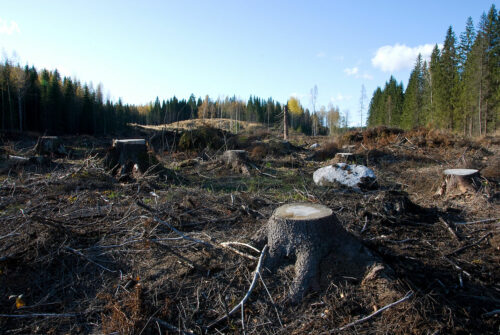Image courtesy of Wikimedia Commons
Take a look around the room you’re in and see if you can find any items made of wood; there are probably quite a few. While wood is an essential material in the manufacturing industry, poor harvesting methods can devastate forest ecosystems and limit long-term timber availability. A former Yale College undergraduate, Romy Carpenter, working under the supervision of Mark Asthon, investigated a chronosequence of forest harvests in the Yale-Myers forest to study how irregular shelterwood harvesting affects soil composition over time.
“The foundation of this paper is this chronosequence of [irregular] shelterwood harvests,” Carpenter said. A chronosequence is a set of forest sites, each having similar characteristics but a different age (time since the forest has been harvested). Each section of the forest is like one frame from a time-lapse, so imagine the difficulty of waiting 25 years to watch one section of forest develop! By using a chronosequence instead, research can be performed much more quickly.
While normal shelterwood cuts leave individual parent trees standing, irregular shelterwood cuts leave groups of reserved trees standing. “[These cuts] mimic a natural disturbance because there are certain stands of trees that are left remaining, and those stands of trees provide canopy shade and a seed source for regeneration,” Carpenter said.
Carpenter took soil samples from irregular shelterwood harvest sites at all different stages of regeneration after harvesting and tracked soil nutrients such as carbon, nitrogen, calcium, magnesium, and potassium. Increased nutrient availability is common in the first years after a harvest due to decomposition of debris and less plants taking up nutrients, but after the initial uptick, soil nutrient levels usually drop for a long time. However, the study uncovered exciting trends in the soil composition of the chronosequence. “This forest type is able to re-organize and reassimilate the nutrients back within a relatively short period of time,” Ashton said. All important macronutrients recovered within the twenty-five-year timespan studied.
Carpenter also investigated the changes in isotope composition of the soil. Elements exist in multiple isotopes (atoms of the same element with different weights), and the proportion of carbon isotope δ13C is closely related to the rate of organic matter cycling in an environment. “The proportion of δ13C changes with how quickly organic matter cycles. If δ13C is higher, it’s indicative of a slower cycle,” Carpenter said. The amount of δ13C decreased after the harvest, indicating that fast-cycling carbon from sources like debris from the harvest recovered quickly.
These data provide evidence that irregular shelterwood harvests are a sustainable forest management technique that facilitate quick soil nutrient recovery. Carpenter also viewed the project as a starting point to begin her career; she now works as a soil chemist in Maine creating soil nutrient management plans. Carpenter’s work is part of a larger study of the Yale-Myers Forest chronosequence; researchers are also investigating ecological impacts of harvesting on organisms such as birds and amphibians. Insights gleaned from these studies will hopefully steer timber production towards a more sustainable future.

